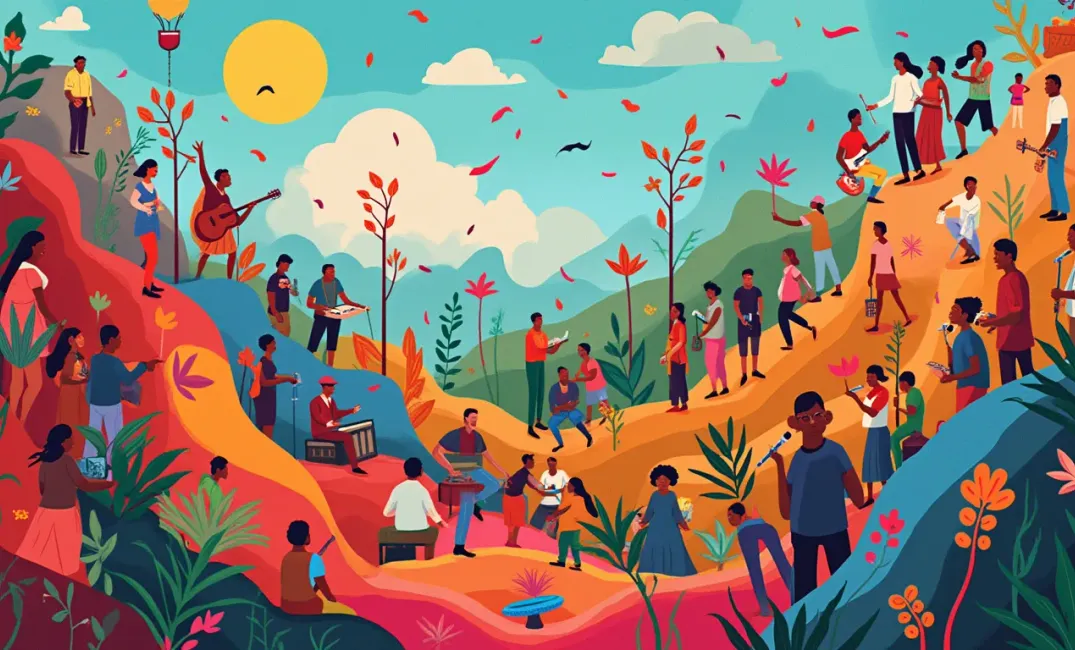Introduction: The Essence of Cultural Resilience
Culture, the collective fabric of human expression, encompasses traditions, languages, arts, beliefs, and customs. It acts as both a beacon and a refuge, fostering identity, continuity, and resilience. Throughout history, societies have faced adversities—be it through conquest, migration, or natural catastrophes—but culture has always played a crucial role in preserving the essence of humanity. In this exploration, we delve into how cultures have withstood trials, adapted, and remained vibrant, ensuring human continuity even as civilizations transformed.
The Enduring Strength of Tradition
Traditions as Pillars of Stability
- Rituals and Celebrations: Throughout history, communal rituals, festivals, and ceremonies have reinforced societal bonds, providing a sense of belonging and continuity. From Indigenous powwows in North America to the Diwali festival in India, these traditions encapsulate shared histories and values that transcend generational divides.
- Oral Traditions and Storytelling: Before written language, oral traditions served as the primary means of preserving history, ethics, and values. Through epic tales, folklore, and songs, communities across Africa, Oceania, and the Americas have maintained their cultural memory, ensuring resilience against forces that attempted to erase their identity.
Adapting to Change While Preserving Core Values
- Innovation in Tradition: Cultures often adapt to external influences while preserving core values. The Japanese tea ceremony, for instance, incorporates foreign elements but remains rooted in Zen principles, illustrating cultural innovation and continuity.
- Survivance in Indigenous Cultures: For many Indigenous peoples, survivance revolves around resilience and active resistance against cultural erasure. Through revitalization of languages, crafts, and governance systems, Indigenous societies assert their identity, resisting assimilation while encouraging cultural renaissance.
Language as the Heartbeat of Culture
Preserving Linguistic Heritage
- Revitalization Efforts: Endangered languages represent an urgent cultural challenge. Communities globally—from the Maori in New Zealand to the Irish Gaels—are actively revitalizing their languages through education, media, and technology, reversuring cultural identity and pride.
- Language as a Cultural Conduit: Language shapes worldview. The Inuktitut language, for example, contains rich linguistic nuances that describe the Arctic environment in ways other languages cannot. Such linguistic expressions deepen cultural understanding and persist even amid pressures to adopt dominant languages.
The Impact of Globalization on Linguistic Diversity
- The Spread of Global Languages: English, Mandarin, and Spanish have become lingua francas in business, science, and media. While facilitating cross-cultural communication, they also pose challenges to linguistic diversity, emphasizing the importance of protecting local dialects and languages.
- Media and the Digital Realm: Digital platforms offer opportunities for linguistic preservation. Social media, podcasts, and online communities empower minority languages by extending their reach and providing forums for native speakers to connect, teach, and learn.
Arts and Crafts: Guardians of Cultural Expression
The Resilience of Visual Arts and Crafts
- Arts as Resistance and Reflection: Art often serves as both refuge and protest. During apartheid in South Africa, 'township art' provided social commentary, asserting cultural identity despite systemic repression. Similarly, Indigenous artists globally utilize traditional techniques to convey contemporary themes, celebrating resilience and resistance.
- The Mastery of Craftsmanship: Traditional crafts, from pottery and weaving to metalwork and basketry, encapsulate cultural narratives and skills passed down for generations. Efforts to document and teach these crafts preserve cultural knowledge, supporting communities economically and culturally.
Cultural Exchange and Craft Evolution
- The Influence of Trade and Colonization: Trade routes have historically facilitated cultural exchange in arts. Chinese ceramics influenced European porcelain, while African textiles shaped patterns in modern fashion. Despite the destructive impacts of colonization, crafts adapt by blending old and new, creating unique expressions of identity.
- Modern Interpretation of Traditional Arts: Modern artists reinterpret traditional motifs, ensuring cultural relevance while innovating. Contemporary African artists employ digital media while utilizing traditional patterns, connecting past influences with present realities.
Spirituality and Religion in Overcoming Adversity
Religious Persistence and Adaptation
- Syncretism in Belief Systems: Syncretism merges diverse religious traditions into cohesive belief systems. The Afro-Brazilian religion Candomblé integrates African, Indigenous, and Catholic elements, reflecting the resilience of faith as cultures with shared experiences meld spiritual expressions.
- Preservation through Diaspora: Diasporic communities maintain spiritual connections through practices assimilated into local contexts. Jewish communities, whether in North America or Ethiopia, continue to observe ancient traditions while engaging with contemporary societal norms.
Faith as a Source of Strength
- Religion and Hope: Faith often provides solace and strength during crises, offering community support and moral frameworks. This is evident in communities recovering from wars or natural disasters, where religious practices seem to foster resilience and hope.
- Spiritual Teachers and Movements: Spiritual leaders—like Mahatma Gandhi, Martin Luther King Jr., or the Dalai Lama—harnessed religious teachings to inspire transformative social movements, weaving moral resilience into the fabric of resistance against injustice.
Education as the Bridge between Generations
Intergenerational Knowledge Transfer
- Cultural Education Initiatives: Educational programs that embed cultural heritage within curricula support identity formation and cultural pride. Indigenous school programs emphasize languages, history, and traditional ecological knowledge, empowering youth to carry cultural legacies forward.
- Cultural Institutions and Preservation: Museums, cultural centers, and archives play pivotal roles in safeguarding and interpreting cultural artifacts. They create spaces for dialogue, reflection, and learning, ensuring cultures thrive even when physical ties to homelands weaken due to diaspora or conflict.
Digital Technologies in Cultural Education
- Virtual Reality and Augmented Reality: Immersive technologies offer novel ways to experience and preserve cultural heritage. Virtual reality recreates historical sites and ceremonies, providing accessible platforms for exploring and understanding diverse cultural narratives.
- Online Platforms and Cultural Narratives: Platforms like YouTube, podcasts, and blogs enable cultural education beyond formal settings, empowering communities to share stories, traditions, and knowledge with global audiences.
Conclusion: The Ever-Enduring Flame of Cultural Resilience
Cultural resilience embodies humanity's ability to adapt, preserve, and flourish amidst adversity. It tells stories of defiance and renewal, transforming adversities into opportunities for growth and unity. As humanity confronts unprecedented challenges, the strength of culture will remain a guiding star, reminding us of shared bonds and the innate human drive to preserve identity.
Yet, the real power lies in our collective will to nurture cultural diversity as a universal heritage—a wellspring from which future generations draw strength, inspiration, and wisdom. Embracing cultural resilience charts a path forward, illuminating the timeless journey of human expression, unity, and endeavor.
"Culture is the soul's unyielding answer to adversity—an immortal symphony of human stories, dreams, and whispers that weave the fabric of our shared history and unknown futures." — *Author Unknown*
TRADITION, ARTS, IDENTITY, LANGUAGE, CULTURAL RESILIENCE, GLOBALIZATION, EDUCATION, SPIRITUALITY

